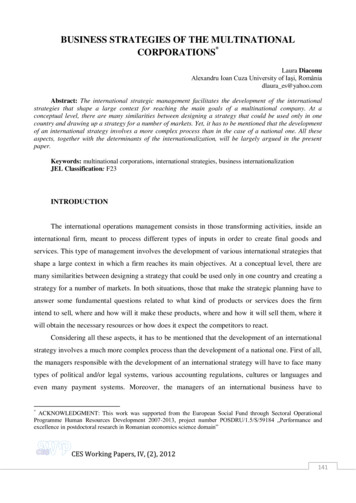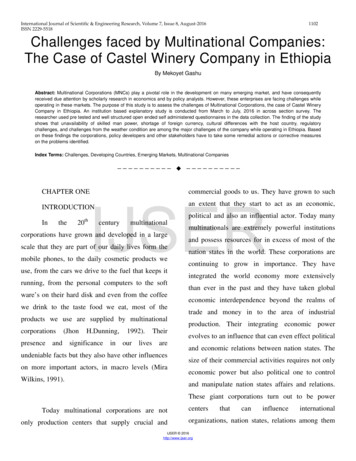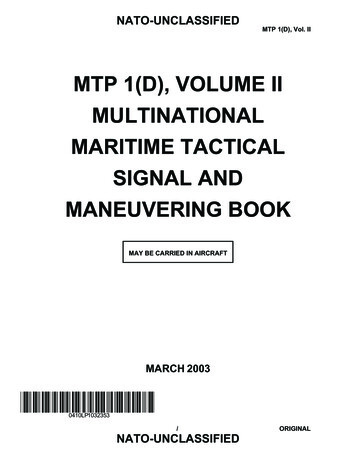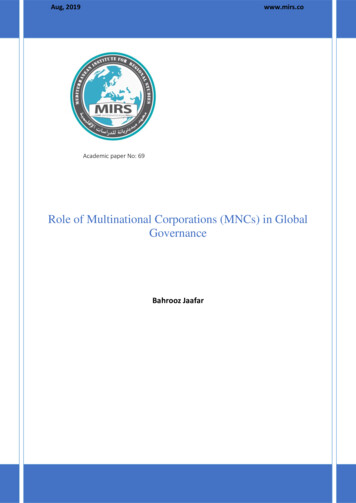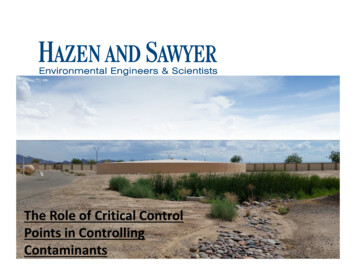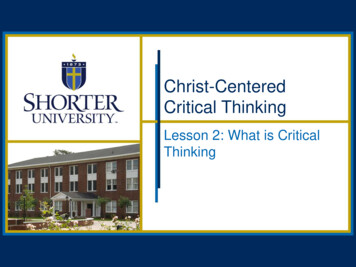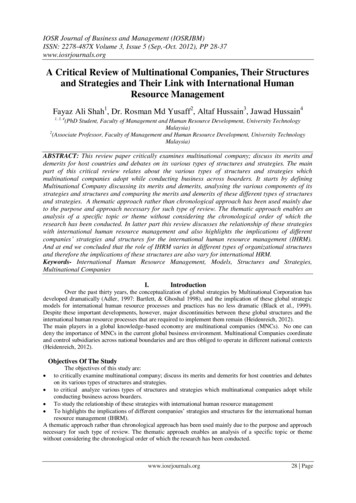
Transcription
IOSR Journal of Business and Management (IOSRJBM)ISSN: 2278-487X Volume 3, Issue 5 (Sep,-Oct. 2012), PP 28-37www.iosrjournals.orgA Critical Review of Multinational Companies, Their Structuresand Strategies and Their Link with International HumanResource ManagementFayaz Ali Shah1, Dr. Rosman Md Yusaff2, Altaf Hussain3, Jawad Hussain41, 3, 4(PhD Student, Faculty of Management and Human Resource Development, University TechnologyMalaysia)2(Associate Professor, Faculty of Management and Human Resource Development, University TechnologyMalaysia)ABSTRACT: This review paper critically examines multinational company; discuss its merits anddemerits for host countries and debates on its various types of structures and strategies. The mainpart of this critical review relates about the various types of structures and strategies whichmultinational companies adopt while conducting business across boarders. It starts by definingMultinational Company discussing its merits and demerits, analysing the various components of itsstrategies and structures and comparing the merits and demerits of these different types of structuresand strategies. A thematic approach rather than chronological approach has been used mainly dueto the purpose and approach necessary for such type of review. The thematic approach enables ananalysis of a specific topic or theme without considering the chronological order of which theresearch has been conducted. In latter part this review discusses the relationship of these strategieswith international human resource management and also highlights the implications of differentcompanies’ strategies and structures for the international human resource management (IHRM).And at end we concluded that the role of IHRM varies in different types of organizational structuresand therefore the implications of these structures are also vary for international HRM.Keywords- International Human Resource Management, Models, Structures and Strategies,Multinational CompaniesI.IntroductionOver the past thirty years, the conceptualization of global strategies by Multinational Corporation hasdeveloped dramatically (Adler, 1997: Bartlett, & Ghoshal 1998), and the implication of these global strategicmodels for international human resource processes and practices has no less dramatic (Black et al., 1999).Despite these important developments, however, major discontinuities between these global structures and theinternational human resource processes that are required to implement them remain (Heidenreich, 2012).The main players in a global knowledge-based economy are multinational companies (MNCs). No one candeny the importance of MNCs in the current global business environment. Multinational Companies coordinateand control subsidiaries across national boundaries and are thus obliged to operate in different national contexts(Heidenreich, 2012).Objectives Of The StudyThe objectives of this study are:to critically examine multinational company; discuss its merits and demerits for host countries and debateson its various types of structures and strategies. to critical analyze various types of structures and strategies which multinational companies adopt whileconducting business across boarders. To study the relationship of these strategies with international human resource management To highlights the implications of different companies‟ strategies and structures for the international humanresource management (IHRM).A thematic approach rather than chronological approach has been used mainly due to the purpose and approachnecessary for such type of review. The thematic approach enables an analysis of a specific topic or themewithout considering the chronological order of which the research has been conducted. www.iosrjournals.org28 Page
A Critical Review Of Multinational Companies, Their Structures And Strategies And Their Link WithII.Definition Of MncThere is no universally accepted definition of a multinational company available. MultinationalCorporations have been broadly defined as business firms that uphold value added-holdings overseas.According to Spero and Hart (1999) a multinational corporation (MNC) as a business enterprise that maintainsdirect investments overseas and that upholds value-added holdings in more than one country. An enterprise isnot truly multinational if it only operates in overseas or as a contractor to foreign firms. A multinational firmsends abroad a package of capital, technology, managerial talent, and marketing skills to carry out production inforeign countries. Dunning (2008) supports the same view and defining MNC as an enterprise that engages inforeign direct investment (FDI) and owns or, in some way, controls value added holdings in more than onecountry.Hennart (2008) defines MNC in a different way that they are a privately owned institution devised toorganise, through employment contracts, interdependencies between individuals located in more than onecountry. while Multinational Corporations according to Kogut and Zander (2003) are economic organisationsthat grow from its national origins to spanning across borders. As an ILO (2010) report observe “The essentialnature of a multinational company lies in the fact that its managerial headquarter is located in one country whilethe company carries out operation in a number of other countries as well.”Merits Of Mncs According to Heidenreich, (2012) and ILO (2010) the main merits and demerits of MNCs are:Help to increase investment, income and employment in host country.Transfer technology to developing countries.Make a commendable contribution to inventions and innovationsDEMERITS OF MncsIt is true that MNCs have some advantages for host countries however; MNCs have been criticised onthe following grounds. MNCs technology is designed for world wide profit maximisation, not for the development need of poorcountries. Through power and flexibility, MNCs can evade national economic autonomy and control, and theiractivities inimical to the national interest of particular countries. MNCS cause fast depletion of some of the non-renewable natural resources in the host countryStrategic ObjectivesIn this part of the review we will discuss strategic objectives of MNCs and will show how MNCsfollow different competitive strategies to achieve these objectives.(Bartlett & Ghoshal, 1992), suggest that, there are three strategic objectives of MNCs. Global efficiency Flexibility Organizational learning (transfer of information)As Bartlett & Ghoshal suggest, these objectives are very important for MNCs, although their degree ofimportance vary from company to company. For global efficiency it is necessary to realize that every possiblesource of competitive advantage has been identified and utilized. It is important to realize that global efficiencycan be enhanced both by increasing revenues and by lowering costs. Important factors influencing efficiencyinclude labour, productivity, capital intensity, economies of scale, learning-curve effects and a company costculture generally (john et al., 1997)Multinational flexibility according to Bartlett and Ghoshal (2000) means “the ability of a company tomanage the risks and explore the opportunities that arise from the diversity and volatility of the globalenvironment.” Lastly, a major objective of MNCs is facilitating learning across units. In addition to encouragingnew learning, MNCs also encourage and facilitate the transfer and sharing of new knowledge.III.Definition Of StrategyAccording to chandler (1962) “strategy is the determination of the basic long-term goals and objectivesof an enterprise and the adoption of courses of action and the allocation of the resources necessary for carryingout these goals”Bartlett and Ghoshal (2000), distinguish four different strategic approaches that focus on the differentcombinations of the sources of competitive advantage (the means) and strategic objectives (the ends).www.iosrjournals.org29 Page
A Critical Review Of Multinational Companies, Their Structures And Strategies And Their Link WithIV.Multidomestic/ Multinational StrategyTo achieve different strategic objectives this strategy gives prime importance to one of the means,national differences. This strategy is a collection of relatively independent subsidiaries, each focusing onspecific domestic market. The company manages its business with minimal direction from headquarter. Bydifferentiating their products and services to respond to differences in consumer‟s tastes and preferences andgovernment regulations, these companies achieve global efficiency and increase revenues. Through thisresponsiveness to national differences they also realize the opportunities associated with multinationalflexibility. This is a country-centred strategy therefore, learning remains within country boarders: subsidiariesidentify local needs, but also use their own resources to meet these needs. Bartlett & Ghoshal (2000) call thislocal-for-local innovation (Harzing & Ruysseveldt, 2005)In short, main characteristics of this strategy are below. Decentralised and nationally self sufficient. Sensing and exploiting local opportunities. Knowledge developed and retained within each units.Example of multidomestic industries includes consumer packaged goods e.g. washing powder and retailingAdvantages Decentralization helps local motivation and morale, therefore, increase the firm‟s effectiveness.Customise product offerings and marketing in according with local responsiveness satisfy customer‟s taste.By responding to local differences these companies also achieve global efficiency and increase revenues.Disadvantages It is true that this strategy has some advantages but some criticism is also levelled against this strategy.Inability to realise location economies.Failure to exploit experience curve effect.Failure to transfer core competencies to foreign markets.Lost economies of scale.International StrategyCompanies follow an international strategy focus primarily on one of the ends worldwide learning.This kind of strategy is well designed to serve the need for learning through worldwide sharing of innovation.This strategy is effective if a firm faces weak pressures for local responsive and cost reductions, but it does notdo a very good job in achieving either global efficiency or flexibility. In this kind of strategy the knowledge andcompetencies transfer to foreign markets (Marbey & Salaman, 1995)Shortly the main characteristics of this strategy are below. Sources of core competencies centralized, other‟s decentralized. Weak pressures for local responsiveness and cost reductions. Knowledge developed at the centre and transferred to overseas units.Example of this strategy is Mc Donald‟s.Advantages Worldwide sharing of innovation.This strategy is very efficient at transferring knowledge across boarders.Centralization of core competencies.Disadvantages The following is the main criticism levelled against this strategy.Lack of local responsiveness.Inability to realise location economy.Failure to exploit experience curve effect.Due to centralized system it harms local motivation and morale, therefore reducing efficiency andflexibility.V.Global StrategyIn this kind of strategy the global corporations use all of their resources in a very integrated fashion.All of their foreign subsidiaries and divisions are highly interdependent in both operations and strategy. Thisstrategy is based on an integration of productions to produce standardized products in a highly cost-efficientway. This strategy is good at achieving the need for efficiency through global integration. The concentrationwww.iosrjournals.org30 Page
A Critical Review Of Multinational Companies, Their Structures And Strategies And Their Link Withand centralization of productions and R&D activities associated with global strategy limit flexibility and leavecompanies that follow this strategy vulnerable to political and currency risk. They also limit their ability to learnfrom foreign markets. Therefore, where as in a multi-domestic strategy the managers in each country react tocompetition without considering what is taking place in other countries, in a global strategy, competitive movesare integrated across nations. The same kind of move is made in different countries at the same time or in asystematic fashion (Albrecht, M.H. (2001)In short, the following are the main characteristics. Centralized and globally scaled. Implementation of parent company strategies. Knowledge develops and retains in the centre. Minimal pressure for local responsiveness. Strong pressure for cost reductions.Example: semi conductor industry, Intel and Motorola.Advantages By pooling production or other activities for two or more nations, a firm can increase the benefits derivesform the economies of scale.A firm that is able to switch production among different nations can reduce costs by increasing itsbargaining power over suppliers, workers and host governments.By locating production in low-cost countries and making standardize product a company can cut costs.Worldwide availability, serviceability and recognition can increase performance through reinforcement.The company is provided with more points from which to attack and counterattack competition.Disadvantages It is true that this strategy has some advantages but some disadvantages of this strategy are below.Through increased, reporting requirements and added staff, substantial management cost can be incurred.Over centralization can harm local motivation and morale, therefore reducing the firm‟s effectiveness.Standardization can result in a product that does not totally satisfy any customer.Incurring costs and revenues in multiple countries increase risk.This strategy also limits the ability to learn from the foreign markets.Transnational StrategyTo remain competitive this strategy tries to achieve all strategic objectives at the same time. Thetransnation strategy provides global coordination (like the global strategy) and at the same time it allows localautonomy (like the multidomestic strategy).It is a kind of combination of global strategy and multidomesticstrategy. Transnational strategy offers solution to the competing pressures and involves the creation of anintegrated network of units each with a distinct role. It meets all three pressures of local responsiveness,flexibility and global efficiency.It is based on a combination of location-bound and non-location bound firm-specific advantages.In short, following are the main characteristics of this strategy. High pressure for local responsiveness. High pressure for cost reduction. Knowledge develops and shares worldwide. Transfer of core competences.Example of this type of strategy is caterpillar.Advantages Exploitation of experience curve effects and location economies.Customise products offering and marketing in accordance with local responsiveness.Reap benefits of global learning.Disadantages This strategy is criticised on the following grounds.It is a kind of difficult task due to contradictory demands placed on the organization.Due to complexity in nature, difficult to implement.Lost of economies of scale.Units may have power to block initiates and preserve their own autonomy.www.iosrjournals.org31 Page
A Critical Review Of Multinational Companies, Their Structures And Strategies And Their Link WithVI.STRUCTURING OF MULTINATIONAL COMPANIESDesigning an organisation‟s structure that achieves the multiple strategic objectives of internationalbusiness is one of the greatest challenges faced by multinational companies in recent decades. The selection of agood competitive strategy is no doubt very important, but a successful implementation of this strategy dependson the structure and processes of the company in question (Harzing & Ruysseveldt, 2005). In this section wewill discuss MNC‟s structures focussing on the classic approach (classic stages models) of Stopford and Wellsand Bartlett and Ghoshal new approach (four models) and also their advantages and disadvantages.Early StudiesChandler (1962) work on the structure of MNCs is considers the early studies on the structure ofMNCs. Chandler (1962) distinguished four growth strategies: expansion of volume, geographic dispersion,vertical integration and product diversification. These strategies are called for different structures; hence hisadage structure follows strategy. Stopford and Wells‟s (1972) classic study investigated this relationship in aninternational context. Stopford and wells (1972) structural stages model was based on empirical investigation ofthe strategy/structure linkages in 187 large US corporations that define the relationship in terms of two variables(see the figure1.1). The number of products sold internally(foreign product diversity, shown vertically in figure1.1) and The proportional importance of foreign sales to total sales (percentage foreign sales, shown horizontally)A model was constructed that show how MNCs adopt different organisational structures at different stages ofinternational expansion (see figure 1.1)International Division StructureThis type of structure is to be used when both product diversity and foreign sales are low. All theinternational activities are simply concentrated in one international division and the domestic organizationalstructure is left untouched. It is a simple and understandable structure and it does not need a complete overhaulof the organization.ADVANTAGES It creates a central pool of international; experience and expertise.It is effective in cost reduction.Disadvantages Isolation of domestic and international activities limits the transfer of knowledge.Lack of coordination.Division between domestic and international activities hinder the company‟s effectiveness and efficiency.Area Division StructureThis structure prioritizes the geographic or territorial dimension and the MNCs primary division whichare based on area. This structure is good for a company with narrow product line (low level of foreign productwww.iosrjournals.org32 Page
A Critical Review Of Multinational Companies, Their Structures And Strategies And Their Link Withdiversity). In this case the world is divided into separate areas, depending on the size of the market. Each areaoperates rather in an autonomous way.Advantages Responsive to local differences and taste.This structure works well if a company has a narrow product line.Disadvantages Lack of coordination.Failure to transfer information and experience.VII.Product Division StructureThis structure is to be particularly suitable for diversified MNCs with wide products range. In this kindof structure the divisions are created for each product or group of products, and these division are relativelyindependent and autonomous and are responsible for their own value-creating activities (production, R&D,marketing etc)Advantages Due to coordination & rationalization within product group, efficiency is improved.High degree of integration and economies of scale.Transfer of core competence and knowledge.Disadvantages Less responsive to local conditions and differences.Corporate level strategy may be weak in this structure.Global Matrix StructureWhen a company enters into a stage, where both foreign sales and product diversity are high, thenglobal matrix is the ideal structure. This structure combines the advantages of both of the area and productstructure, local responsiveness and global efficiency. In this structure the responsibility for a particular productis shared by both product and area managers (Harzing & Ruysseveldt, 2005).Advantages This structure helps a company to balance product and area requirements and achieve both efficiency andresponsiveness. Transfer of learning and knowledgeDisadvantages Decision making processes become slow and bureaucracy increased.Lack of responsibility and flexibility.Recent DevelopmentNowadays some recent and sophisticated approaches have been developed. Here we will discuss theserecent develop structures described by Bartlett and Ghoshal (2000), multinational, international, global, andtransnational.VIII.Multinational Organizational ModelThis was the classic organization pattern adopted by companies in pre-war period. Economic, politicaland social forces encouraged multinational companies to decentralize their organisational assets and capabilitiesto allow foreign operations to respond differences that distinguish national markets. So the foreign operationswere relatively independent of the headquarters. Control and coordination were achieved primarily through thepersonal relationship between top corporate management and subsidiary managers. Products were customised tomeet differing local demands. This structure gives prime importance to local responsiveness. Decentralizedfederation is the main characteristic of this structure. Example of a multidomestic industry is the brandedpackaged products industry e.g. food and laundry detergents.AdavantagesThe main advantage of this structure is that it gives prime importance to local responsiveness, and through thisachieves global efficiency.www.iosrjournals.org33 Page
A Critical Review Of Multinational Companies, Their Structures And Strategies And Their Link WithDisadvantagesThe main disadvantages of this structure are the inability to realize location economies and also failureto exploit experience curve effect.IX.International Organizational ModelThis type of organizational structure developed in the early post-war decades. The main objective forthe companies in those days was to transfer knowledge and expertise to overseas environments that were lessadvanced in technology or market development. Local do still have some freedom to adopt new products orstrategies, but more important than in the multidomestic type. Some functions in the international model arecentralized and others are decentralized, in particular knowledge, research and development take place at thecentre and are subsequently transferred to subsidiaries. A classic example of an international industry istelecommunications switching.AdavategesThe main advantages of this structure are sharing of worldwide innovation and transfer of knowledgefrom centre to subsidiaries.DisadvantagesThe main disadvantages are the lack of local responsiveness and inability to realise location economy.X.Global Organizational ModelThis type of structure emphasises on efficiency, centralization and control. In global industry,standardize consumer needs and scale efficiencies make centralization and integration profitable. In this kind ofindustry a firm competitive position is significantly influenced by its position in other countries and rivalscompete against each other on truly worldwide basis. In this type of structure the role of offshore subsidiaries islimited, only to assemble and sell products and implement plans and policies developed at headquarters. Ascompared with multidomestic and international organizational mode the subsidiaries in this organizationalmodel have much less freedom of action. The structural configuration of this organization is called central hub.The example of a global industry is consumer electronics (Jain, 1989)AdavantagesBy locating production in low cost countries and making standardize product a company keeps costslow.DisadvantageThis structure limits the ability to learn from the foreign markets and over centralization harms themotivation and therefore, reducing the firm‟s effectiveness.XI.Transnational Organization ModelTo remain competitive this model achieves all three strengths (efficiency, flexibility and localresponsiveness) simultaneously. In 1980s many worldwide industries have adopted transnational form. Thistype of structure is a complex configuration of assets and capabilities in which some functions and resources arecentralized and others decentralized, creating an independent network of specialized units. Expertise is spreadthroughout the organization and subsidiaries can serve as a strategic centre for particular product-marketcombination. This concept is against the traditional concept of having one headquarter and many dependantsubsidiaries. In this type of structure the company becomes a kind of network with different centres for differentactivities. Each centre has a strategic role for a particular area. Example of this kind of structure is caterpillar.AdvantagesThe main advantage of this structure is exploitation of experience curve effect and location economies.www.iosrjournals.org34 Page
A Critical Review Of Multinational Companies, Their Structures And Strategies And Their Link WithDisadvantageDue to its complex nature this structure is difficult to implement.XII.Implications Of Different Company Strat-Egies And Structures For International HrmTo operate in an international environment a human resource department must engage in a number ofactivities like, human resource planning, staffing, training and development, compensation, performancemanagement and industrial relations. In this portion of literature review we will discuss the role of IHRM orimplications for IHRM in context of different types of strategies and structures.Human Resource PlainingWe use the concept of HR policy in generic sense for a wide range of policies, procedures andprocesses, which aim at managing, discipline, motivating and rewarding employees in work organization.IHRM here link the understanding of HR policy to a wide range of company values & strategies, i.e. HR ismore or less integrated in the company culture. It suggests that HR policy not only is a question about educationand training of employees, but also aim at managing the relation between employer and employees anddevelopment of reflexive workforce (Kettunen, 1998). Moreover, it suggests, that success of HR policy isclosely connected to organization and competence development.The challenge is to establish an agenda that motivates employees to become involved and committed tocompany strategies. The main task of IHRM is making and implementation of HR programme which enable afirm to be successful globally.STAFFING (Recruitment, Selection And Placement)The difference between failure and success depends how well organizations select, train and managetheir employees. For international staffing Perlmutter‟s (1969) classic study has described three differentapproaches, ethnocentric, polycentric and geocentric. Companies follow ethnocentric staffing approach wouldmostly appoint parent company nationals. In this type of approach the nationals from parent company dominatethe organisation at home and abroad. While companies follow the polycentric approach appoint mostlynationals from host countries, and companies follow geocentric approach appoint the best persons regardless oftheir nationality.Now linking these different types of staffing approaches to Bartlett and Ghoshal (2000) organizationalmodels as discussed earlier. Global and (up to some extent) international organisational models followethnocentric approach, multidomestic polycentric and transnational geocentric approach.International HRM is concerned with ethnocentric staffing policy because in ethnocentric policy the recruitmentand selection are made at headquarters and subsidiaries have limited autonomy. So, in global and internationalmodels the selection of expatriates, their training, preparation and placement for international role and thewww.iosrjournals.org35 Page
A Critical Review Of Multinational Companies, Their Structures And Strategies And Their Link Withcontrol of human resource in diverse and dispersed population of host countries is the main and crucial role ofIHRM. In this processes the IHRM faces a lot of implications like cultural differences, communication problem,relocation and remuneration.Training And DevelopmentMultinational companies recognize that human resources play an important role in developing andsustaining a competitive advantage in today‟s highly competitive global business environment (Brewster, 2000).The training and development of the human resources perform a variety of purposes such as to acquire andtransfer knowledge, to manage foreign subsidiary and to maintain communication coordination and controlbetween subsidiaries and headquarters. In global and a bit in international organisational models trainingoriginates at headquarters and corporate trainers travel to subsidiaries. To remain globally competitive theIHRM must identify employees with global potential and provide them various training and developmentopportunities. While in multidomestic and transnational organizational models the training and developmentsactivities carry out on local basis.Compensation & RewardAfter selection, training and development of employees, another implication for IHRM is how tocompensate employees in multinational companies. International compensation can be defined as the provisionof monetary and non monetary rewards, including base salary, benefits, long and short-term incentives, valuedby employees in accordance with their relative contributions to MNC performance. Its broad HRM purpose is toattract, retain and motivate those personnel throughout the MNC currently and in the future (Harzing &Ruysseveldt, 2005). In multinational companies the IHRM is mainly concerned with the compensation andreward of employees in global and international structure models, because in global and international modelsthe compensation and reward system is develop and administer in headquarters. While in multidomestic andtransnational structures compensation and reward system is develop in different units and regulated by localHRM. Compensation and reward system for international expatriate is much more complex. The IHRM looksinto various things like foreign services premium, hardship, relocation, education and home leave etc, whengiving comp
Definition Of Strategy According to chandler (1962) "strategy is the determination of the basic long-term goals and objectives . This strategy is good at achieving the need for efficiency through global integration. The concentration . A Critical Review Of Multinational Companies, Their Structures And Strategies And Their Link With


